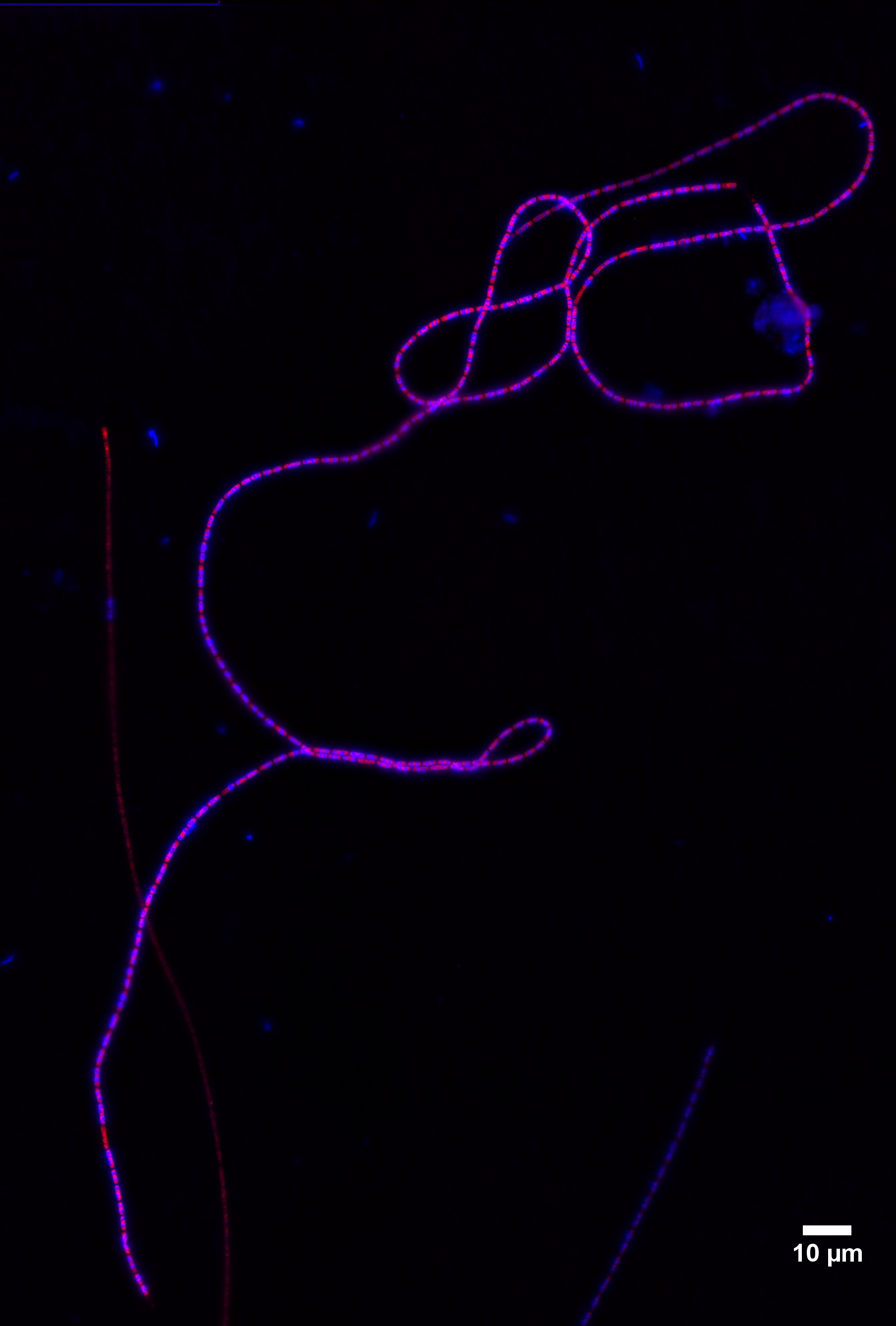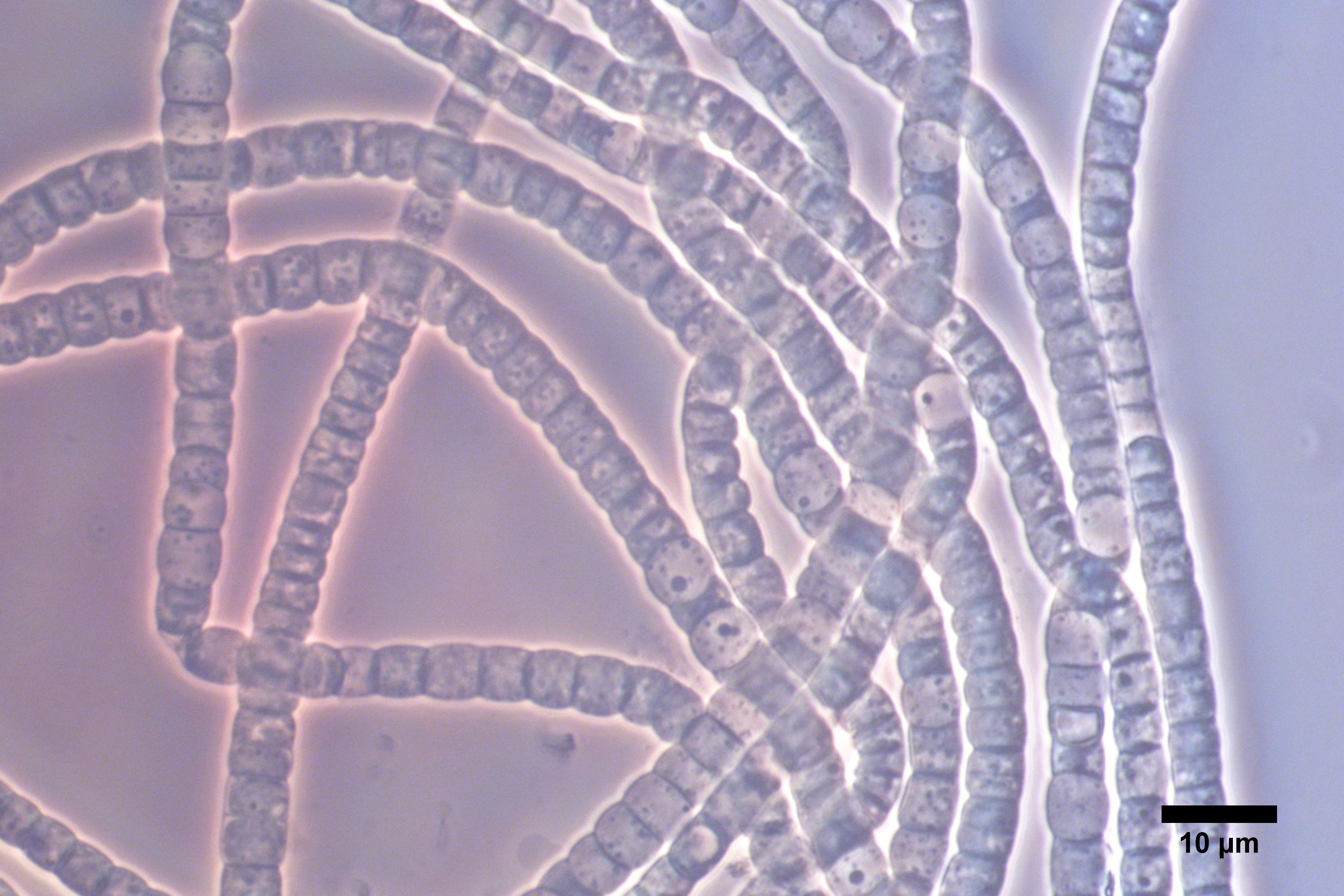Cable bacteria: Living electrical wires with record conductivity
Scientists UAntwerp, UHasselt and TU Delft discover “electrified” bacteria
Bacteria that power themselves using electricity and are able to send electrical currents over long distances through highly conductive power lines. It almost sounds like the way we charge our TVs and refrigerators, and may seem hard to believe, but it is a recent discovery by a team of scientists from the University of Antwerp (Belgium), Delft University of Technology (Netherlands) and the University of Hasselt (Belgium). Centimeter-long bacteria from the seafloor contain a conductive fiber network that operates in comparable way to the copper wiring that we use to transport electricity. The highly conductive fibers enable a completely new interface between biology and electronics, providing a prospect for new materials and technology.
Microbial electricity
The discovery of electricity is considered one of the greatest scientific achievements of humankind and experienced a breakthrough in 1879, when Thomas Edison produced the first durable electric light bulb. Nowadays, modern society thrives on electricity, and an extensive network of power lines and copper wiring ensures the availability of electrical power in offices, kitchens and bedrooms. A new study shows that bacteria in the seafloor produced such electrical networks long before humans did.
Cable bacteria are centimeter-long micro-organisms that consist of thousands cells in a row. ‘These multicellular bacteria were only discovered a few years ago, and we already knew they were doing something exceptional’, explains team leader Prof. Filip Meysman (University of Antwerp).‘ Detailed investigations showed that electrical currents must be running through the seafloor, and all data suggested that the cable bacteria were generating and conducting these currents. Such an electricity-based metabolism would give the cable a huge advantage, being able to harvest energy from deeper layers within the seafloor’. Although a tantalizing idea, there was no direct proof that cable bacteria were indeed conductive.
The new study by the multi-disciplinary team of biologists, chemists and physicists now resolves this enigma. The scientists invented a procedure to extract a single bacterial filament out of the seafloor and attached this thin filament (50 times thinner than a human hair) to a custom-made setup with tiny electrodes. ‘It took us great effort to connect the bacteria’, explains Prof. Herre van der Zant, a physicist from Delft University of Technology. ‘But when we finally succeeded, the results were baffling. We saw that there was a large current going through this thin cable bacterium’.
Bacterial powerlines
The team then further fine-tuned their handling procedure of the bacteria, and at one point, were able to show currents in a filament that was more than 1 cm long. ‘This extends the known length scale of biological electron transport by orders of magnitude and implies that cable bacteria have found a mechanism to efficiently transport charges over centimetre-scale distances‘ says Prof. Jean Manca (University of Hasselt). This observation, however, immediately brought up the next question: what are the conductive structures inside the bacteria that can sustain such high electrical currents? Advanced microscopy revealed that the cell wall of the cable bacteria contains a parallel network of fibers which run along the whole length of the bacteria. ‘We invented a kind of chemical car-wash procedure that removes cell material in a sequential fashion, and eventually only leaves the fibre structure behind’, explains team leader Meysman.
‘When we put this onto our electrode set-up, we again saw high currents, demonstrating that the fibre network in the cell wall is actually the conductive structure’ confirms Prof. De Wael (University of Antwerp), who was responsible for the Electrochemistry analyses in the project. However, the surprise was not over yet. The electrical measurements revealed that the fibres sustained an extremely high electric current per unit of cross-sectional area, which readily compares to the current density that passes in the copper wiring of our household appliances. Even more exciting, the conductivity of the fibres is unusually high, with values exceeding 20 S cm-1. For reference, this conductivity rivals that of the state-of-the-art conductive polymer materials used in flexible solar panels or foldable phones. ‘We were totally surprised when these high numbers first appeared on the display of our instruments’, says Meysman. ‘Somehow, biological evolution has invented a structure with extraordinary electrical properties.’
Bacterial smartphones
The discovery of the highly conductive fibers in cable bacteria is remarkable, as all known biological materials (like proteins, carbohydrates, lipids, nucleic acids) are extremely poor in terms of electrical conduction. The conductive fibers therefore provide a tremendous opportunity for new functional materials and technology, as the prospect of a bio-based material with exceptional electrical properties could push material science and electronics far beyond its current limits. “The use of bio-materials in electronic engineering is an active field of research, for example, to achieve biodegradable electronics, which could reduce the problem of e-waste and allow greener consumer electronics, or they could be applied in health care, where implantable diagnostic and therapeutic devices could function during a certain time frame and then disappear via resorption by the body.” explains Meysman. “Maybe within some years, we will have medical implants or smartphones that are equipped with minuscule conducting wires of bacterial origin.”
More information about the research can be found on the project website:
A description for the broad public and non-experts can be found there.
An enlarged model of a cable bacterium (7 meter long!) is currently on display in the entrance hall of the Technopolis Science & technology Museum (https://www.technopolis.be/en/visitors/)
This study features in the high-impact scientific journal Nature Communications:
Filip J. R. Meysman, Rob Cornelissen, Stanislav Trashin, Robin Bonné, Silvia Hidalgo Martinez, Jasper van der Veen, Carsten J. Blom, Cheryl Karman, Ji-Ling Hou, Raghavendran Thiruvallur Eachambadi, Jeanine S. Geelhoed, Karolien De Wael, Hubertus J. E. Beaumont, Bart Cleuren, Roland Valcke, Herre S. J. van der Zant, Henricus T.S. Boschker, Jean V. Manca. A highly conductive fibre network enables centimetre-scale electron transport in multicellular cable bacteria
DOI: 10.1038/s41467-019-12115-7
Open access: http://www.nature.com/ncomms
The multi-disciplinary research team consists of researchers from:
- Department of Biology, University of Antwerp, Antwerpen, Belgium (team leader: Prof. Filip Meysman)
- Departments of Physics and Biology, University of Hasselt, Diepenbeek, Belgium (team leader: Prof. Jean Manca)
- Department of Chemistry, University of Antwerp, Antwerpen, Belgium (team leader: Prof. Karolien De Wael)
- Departments of Biotechnology, Bionanoscience and Quantum Nanoscience, Delft University of Technology, Nederland (team leader: Prof. Herre van der Zant)
The research was conducted with support of Research Foundation Flanders (FWO), the Netherlands Organisation for Scientific Research (NWO), and the European Research Council (ERC).
Contact information
Responsible scientist:
Prof. dr. ir. Filip Meysman, +32 (0) 494 06 43 27
filip.meysman@uantwerpen.be, F.J.R.Meysman@tudelft.nl
Communication officer UAntwerpen:
Peter De Meyer, Communication officer, T. +32 (0) 3 265 47 11, M. +32 (0)476 20 07 54 peter.demeyer@uantwerpen.be
Communication officer UHasselt:
Koen Santermans, Directeur Communicatie & Marketing van UHasselt, +32 (0) 11 268 009, koen.santermans@uhasselt.be


